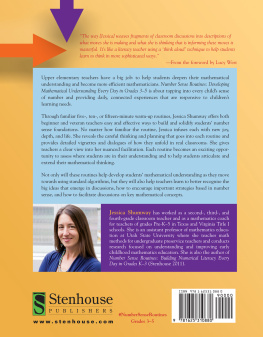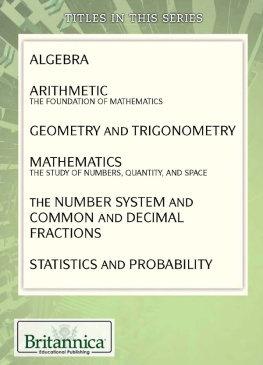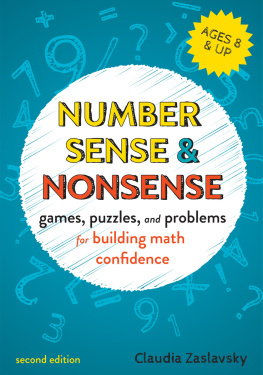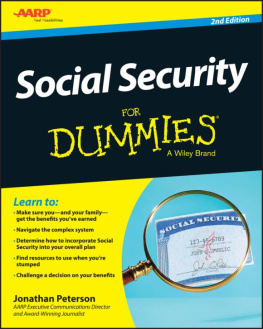Thank you for purchasing this Stenhouse e-book; we appreciate the opportunity to help you become an even more effective teacher. This e-book is for your own individual use: you may print one copy for your own personal use and you can access your e-book on multiple personal devices, including computers, e-readers, and smartphones. However, you cannot make print or digital copies to share with others, nor may you post this e-book on any server, website, or other digital or online system. If you would like permission to distribute or post sections of this e-book, please contact Stenhouse at .
If you would like to see a full list of the e-books Stenhouse offers, please visit us at www.stenhouse/allebooks

Stenhouse Publishers
www.stenhouse.com
Copyright 2018 by Jessica F. Shumway
All rights reserved. This e-book is intended for individual use only. You can print a copy for your own personal use and you can access this e-book on multiple personal devices (i.e. computer, e-reader, smartphone). You may not reproduce digital copies to share with others, post a digital copy on a server or a website, make photocopies for others, or transmit in any form by any other means, electronic or mechanical, without permission from the publisher.
Every effort has been made to contact copyright holders and students for permission to reproduce borrowed material. We regret any oversights that may have occurred and will be pleased to rectify them in subsequent reprints of the work.
Credit
: Excerpts from GO MATH!, Common Core, Teacher Edition. Copyright 2015 by Houghton Mifflin Harcourt Publishing Company. All rights reserved. Included by permission of the publisher, Houghton Mifflin Harcourt Publishing Company.
Library of Congress Cataloging-in-Publication Data
Names: Shumway, Jessica F., author.
Title: Number sense routines. Building mathematical understanding every day in grades 3-5 / Jessica Shumway.
Description: Portland, Maine : Stenhouse Publishers, 2018. | Includes bibliographical references and index. |
Identifiers: LCCN 2017045004 (print) | LCCN 2017055062 (ebook) | ISBN 9781625310897 (ebook) | ISBN 9781625310880 (pbk. : alk. paper)
Subjects: LCSH: Mathematics--Study and teaching (Primary) | Mathematics--Study and teaching (Elementary)
Classification: LCC QA135.53 (ebook) | LCC QA135.53 .S5725 2018 (print) | DDC 372.7/044dc23
LC record available at https://lccn.loc.gov/2017045004
Cover design, interior design, and typesetting by Martha Drury
Manufactured in the United States of America

24 23 22 21 20 19 18 9 8 7 6 5 4 3 2 1
For Benjamin, David, and Nathaniel.
CONTENTS
FOREWORD
Lucy West
S o often in education we learn to do something one particular way and then do it that way forevermore. For example, in elementary grades, we may use the same routines over and over again in the same old ways because we are expected to have a warm-up in our math block. Sometimes we are told to use particular routines or they show up in our curriculum materials, and we basically follow directions and walk through them, expecting to get good results without fully understanding why we are doing the routines or how to get the most learning out of them. Jessica Shumways book, Number Sense Routines: Building Mathematical Understanding Every Day in Grades 35, wakes us up and challenges us to infuse new life, depth, and joy into the warm-up segment of our math block. I love that she has written a whole book about how to dive into the warm-up aspect of the block and has shown us how rich and rewarding these few minutes can be using these tried-and-true routines.
Jessicas breadth of experience with these routines, her easy-to-follow writing style, the clarity and specificity with which she writes are designed to assist every upper grade elementary teacherno matter how new or experiencedto awaken students to the beauty and power of mathematics. Jessicas conversational tone and myriad examples of actual classroom conversations bring to life the power of using a few basic number sense routines purposefully, intentionally, and deliberately to develop childrens mathematical minds. The book is filled with rich examples of how to use routines like Todays Number, Quick Images, and Counting Around the Circle (familiar to anyone who has worked with the Investigations in Number Data and Space curriculum materials) in creative and sophisticated ways.
Oftentimes, we think, Oh I already do those routines. I strongly encourage you to get a cup of your favorite relaxing drink and dive into the descriptions of the myriad ways these routines can be extended, deepened, enriched, and utilized to address the common concerns expressed by so many teachers. When taught well, these routines address issues related to differentiation, creating true learning communities in which students listen to and learn from one another, provide windows into student thinking that inform instruction, help students make connections across mathematical ideas, and deepen a teachers capacity to assess what individual students know and can do.
The key to really getting the most out of the routines Jessica describes is to attend to the thinking she shares about how she plans and facilitates them. The complexity of her practice is nuanced and revealing if you read between the lines. She discusses the care she takes in the choice of routine, the choice of numbers, and the images or visuals she uses to give students entry to rich concepts and connections in mathematics. Pay attention to the varied ways she invites and encourages students to talk and share their thinking and questions and mistakes. Notice the techniques she uses to develop safety and robust dialogue ( so clear and straightforward, I am looking forward to sharing it with colleagues. Shes one of those teachers who is just so conscious of what she is doing and why that she helps the rest of us do the same.
Although these routines may appear in other places, I have never seen them written in such detail and with so many variations. The way she weaves fragments of classroom discussions into descriptions of the moves she is making and what she is thinking that is informing these moves is masterful. Its like a literacy teacher using a think-aloud technique to help students learn to think in more sophisticated ways. Although she makes what she does sound easy, we all know that teaching math well is anything but easy. It is challenging and complex. Unpacking what students are saying, helping them make connections not only to the math but to each others ideas, while simultaneously recording their ideas using mathematical models, visuals, or equations is no easy task. Jessica provides wonderful visuals, examples of student work, and so much more to help educators develop the tools they need to improve their practice and in so doing improve student learning.
Jessica names the numerous and significant mathematical ideas that can be brought out in each of these routines. She shares the various strategies students are likely to come up with as well as the confusions that might surface by telling us what students have actually said. The dialogues shared in the book, when read carefully, will help teachers name the moves they need to make, see the curiosity and compassion with which they need to listen to their students thinking, and determine when to let something wait until tomorrow when they can come back and rethink or extend their ideas. I especially like her emphasis on the importance of estimationan important mathematical habit of mind that generally gets short shrift in many classrooms or is turned into getting it right instead of making it reasonable.
Next page







